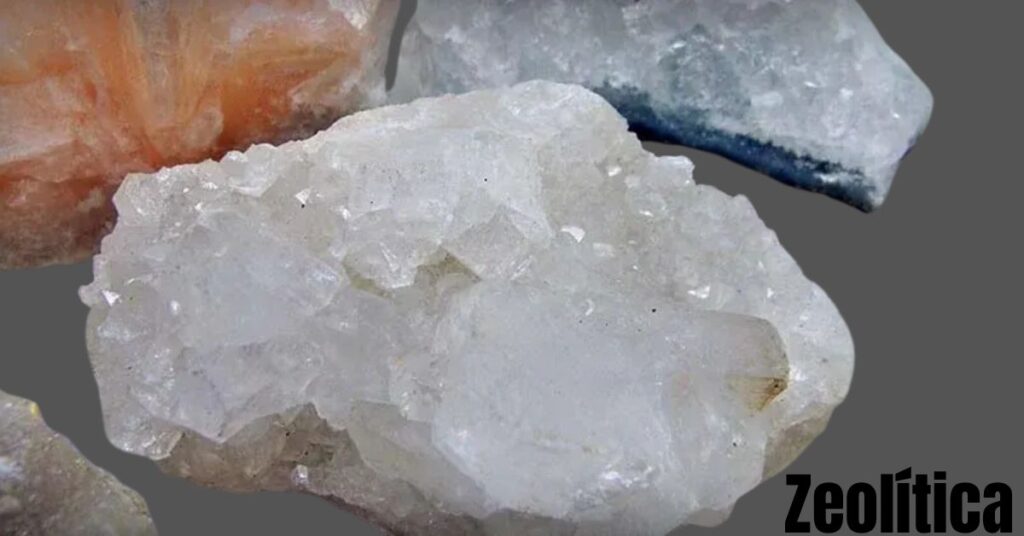
Industry and scientists have been fascinated by zeolíticas, a class of minerals with intriguing microporous properties, for millennia. Natural zeolíticas, which can be found worldwide, are highly valued for their exceptional qualities, which has led to their extensive application in soil remediation, air pollution reduction, and water purification. Synthetic zeolíticas have recently opened up new avenues for innovation and revolutionized various sectors with their remarkable capabilities as sophisticated materials, catalysts, and adsorbents. This article explores the fascinating world of zeolíticas, revealing their natural beauties and the marvels they bring to many sectors, from their geological origins to their cutting-edge uses.
Contents
Natural zeolíticas: geological treasures
Natural zeolíticas—minerals produced by volcanic processes—are found nowhere else in geology and industry. These minerals are precious because of their extraordinary microporous textures, which give them unique characteristics. Natural zeolíticas can be found worldwide, particularly in Southeast Asia, Europe, and the United States. Each deposit has unique properties that make it useful for various uses.
Zeolíticas exist in various forms; clinoptilolite, mordenite, and analcime are just a few. Clinoptilolite is an excellent performer in soil remediation and water purification due to its strong cation exchange capacity and adsorption capabilities. With its distinct pore structure and remarkable thermal stability, mordenite finds application in the catalysis and gas separation processes. Analcime excels in detergent formulations and as an alumina source due to its high aluminum concentration and hydrothermal stability.
These geological marvels are made much more fascinating by the historical significance of natural zeolíticas. Recognizing their potential, ancient societies used them for various tasks, such as building materials, medical applications, and water purification. Natural zeolíticas have long been valued for their intrinsic qualities and adaptability, contributing significantly to human history and technological progress.
In addition, enterprises looking for eco-friendly solutions find natural zeolíticas appealing due to their sustainability and kindness to the environment. Their low ecological impact and ability to remove contaminants from soil and water are ideal for meeting the growing need for sustainable practices.
To sum up, natural zeolíticas are genuinely valuable geological resources that present an alluring combination of distinct characteristics, varied uses, historical importance, and ecological sustainability. These extraordinary minerals have the potential to transform businesses and lead to a more environmentally friendly future, and research into their properties is still ongoing.
Synthetic zeolíticas: human ingenuity at work
According to materials science, synthetic zeolíticas are a marvel of our ingenuity and ability to use nature’s wonders for technological advancement. These synthetic materials provide control and customization that have changed industries and advanced science by imitating the complex microporous architectures in natural zeolíticas.
Compared to their natural counterparts, which may vary depending on geological conditions, synthetic zeolíticas offer a regular and dependable supply of materials with specific characteristics. Scientists can create these materials to have improved purity, homogeneity, and particular properties that satisfy the needs of contemporary applications by varying synthesis parameters, including temperature, pressure, and composition.
This degree of control has opened up a world of possibilities for synthetic zeolíticas. They are widely used as cutting-edge materials, adsorbents, and catalysts, propelling technological progress in various industries. They are essential in multiple industries, from gas separation and environmental cleanup to ion exchange and catalysis, due to their ability to satisfy exact specifications and produce repeatable results.
Zeolíticas can also be synthesized to create materials with certain surface areas, pore configurations, and chemical makeups. Scientists can now enhance zeolítica performance for particular processes and applications thanks to this degree of customization, which creates new opportunities for innovation. By creating zeolíticas with specific characteristics, researchers can increase efficiency, efficacy, and selectivity, which could result in ground-breaking developments in environmental science, biomedical engineering, and energy storage.
Synthetic zeolíticas push the limits of what is possible with these extraordinary materials, symbolizing a triumph of human creativity. Scientists have opened up a world of possibilities by carefully adjusting synthesis parameters, revolutionizing numerous businesses, and advancing science in other fields.
Unveiling zeolítica applications: from industry to everyday life
Zeolíticas are widely used in both daily life and industry. They are employed in industry as soil additives to promote plant development, adsorbents to remove air and water pollutants, and chemical reaction catalysts. Materials based on Zeolítica are also utilized in the building sector for fire resistance, soundproofing, and insulation.
Zeolíticas are commonly found in various items, such as toothpaste, kitty litter, and detergents. They are also utilized in air purifiers and water filters to eliminate pollutants. Zeolíticas are used even in some medications and cosmetics.
Zeolíticas’ unique qualities account for their adaptability. They can catch and release molecules because of their large surface area and porous nature. They are, therefore, perfect for a wide range of uses, including water filtration and catalysis.
Catalysis is one of the most essential uses for zeolíticas. Zeolíticas are employed as catalysts in various chemical processes, such as those that manufacture polymers, medicines, and fuels. Zeolíticas give the reactants a surface to adsorb, which helps quicken these reactions. As a result, the reactants can come into closer contact with one another, speeding up the reaction rate.
Additionally, zeolíticas are adsorbents to draw impurities out of the air and water. Zeolíticas can capture contaminants, including organic molecules, radioactive elements,nts, and heavy metals. They are, therefore, perfect for wastewater treatment facilities, water filters, and air purifiers.
Zeolíticas are utilized in several everyday products in addition to their industrial uses. Zeolíticas aid in removing filth and grime from clothing, which is why they are in detergents. Because they aid in tooth whitening and plaque removal, they are also in toothpaste. Zeolíticas are so effective at absorbing moisture and odor that they are even used in cat litter.
Due to their versatility, zeolíticas are an invaluable resource for industry and daily life. Because of their unique qualities can be utilized for various purposes, such as water filtration and catalysis. Zeolíticas are a genuinely fantastic material with a multitude of possible applications.
Zeolítica structures: a microscopic wonderland
Zeolíticas are minerals distinguished by their extraordinary characteristics due to their distinct microporous architectures. They are widely distributed worldwide and have long been valued for their numerous applications, including soil remediation, air pollution reduction, and water purification. The creation of artificial zeolíticas has recently transformed several sectors by making it possible to produce cutting-edge materials, catalysts, and adsorbents.
The unique structures of zeolíticas, which give them their remarkable qualities, will be covered in this section. We will investigate the roles of exchangeable cations, zeolíticas’ structure, and pore sizes and shapes.
The microscopic world of zeolíticas is characterized by a network of pores and channels that resembles a honeycomb. These holes can catch and release particular molecules according to size and shape because their diameter is usually between 0.3 and 1.0 nanometers. Because of their molecular sieving ability, zeolíticas help separate and clean liquids and gasses.
Tetrahedrally coordinated silicon and aluminum atoms connected by oxygen atoms make up the structure of zeolíticas. Zeolíticas’ great mechanical strength and thermal stability are attributed to this structure. Positively charged ions easily exchangeable with other cations are also present in the framework. Zeolíticas’ ion exchange and catalytic characteristics depend heavily on these exchangeable cations.
Zeolíticas have a vast surface area due to their unusual structure, which is crucial for their adsorption and catalytic capabilities. Zeolíticas have surfaces varying from 500 to 1,000 square meters per gram; one gram of Zeolítica can cover the size of a football field. This large surface area makes numerous adsorption sites and active chemical reactions possible.
To sum up, the remarkable qualities of zeolíticas are attributed to their distinct microporous structures, which are defined by their pore sizes, morphologies, framework, and exchangeable cations. Because of these characteristics, zeolíticas are helpful for several processes, such as gas separation, ion exchange, catalysis, and environmental remediation.
Environmental Champions: zeolíticas in action
Zeolíticas are adaptable substances with a wide range of uses in environmental preservation. They are perfect for eliminating soil, water, and air contaminants because of their remarkable adsorption capabilities.
Zeolíticas are ion exchangers in water filtration to eliminate organic pollutants, heavy metals, and other impurities. They are essential for nuclear waste management and water treatment facilities because they are very good at removing radioactive materials like uranium and plutonium from water. Zeolíticas are also necessary for treating wastewater because they help eliminate dangerous contaminants and enhance water quality.
Zeolíticas are also helpful in reducing air pollution. They are employed in catalytic converters to lessen dangerous car emissions. Nitrogen oxides and sulfur dioxide are two other contaminants that zeolíticas can eliminate from industrial emissions. Zeolíticas are also used in air purifiers to stop allergens such as dust, pollen, and others from indoor air, enhancing air quality and lowering respiratory issues.
Zeolíticas are used in soil remediation to eliminate pesticides, heavy metals, and other pollutants. Providing vital nutrients and improving water retention can help increase soil fertility. Zeolíticas are also utilized in agriculture to lessen the environmental impact of fertilizers and pesticides.
Zeolíticas benefit the environment beyond these immediate uses and improve sustainability and energy efficiency. They lower energy usage and waste creation in various industrial processes by acting as catalysts. Zeolíticas are also utilized to increase the effectiveness and performance of energy storage devices like fuel cells and batteries.
Zeolíticas are solid and adaptable substances that are essential to environmental preservation. Because of their unique qualities, they are necessary for several applications, such as soil remediation, energy efficiency, air pollution management, and water purification. Zeolíticas are anticipated to find even more creative and long-lasting uses as research and development continue, helping to create a cleaner and healthier environment.
conclusion
Because of their extraordinary qualities, natural and artificial zeolíticas have found countless uses in various industries. They are instrumental in catalysis, adsorption, and separation due to their high porosity, wide surface area, and ion exchange capabilities. Zeolíticas are effective catalysts for various chemical reactions in the field of catalysis, including the reforming, isomerization, and cracking of hydrocarbons, which are essential for producing fuels, polymers, and medicines. Zeolíticas are perfect for air pollution management, water purification, and gas separation because of their capacity to adsorb particular molecules selectively.
Zeolíticas’ eco-friendly properties have led to an increase in their range of applications. Zeolíticas efficiently eliminate organic contaminants, radioactive elements, and heavy metals from water, resulting in clean, safe drinking water. Additionally, they are essential to wastewater treatment, which lessens the harm industrial effluents cause to the environment. Zeolíticas are helpful in soil remediation because of their ion-exchange capabilities, which remove pollutants and heavy metals while enhancing soil fertility and water retention.
As new applications are made possible by research and innovation, the potential of zeolíticas keeps expanding. Zeolíticas are being investigated for their potential to store carbon dioxide and hydrogen in energy storage, which could lead to viable solutions for carbon capture and renewable energy. Zeolíticas exhibit significant potential in biological applications, including tissue engineering and medication delivery systems. With the advancement of science and technology, there will be even more exciting opportunities to use zeolíticas in various industries.
FAQs
The following are some zeolíticas-related commonly asked questions:
Q: Are zeolíticas safe?
A: Most people agree that zeolíticas are safe for various applications. They have been thoroughly investigated and employed for many years in multiple industries without raising any serious safety issues. It is important to remember that some zeolíticas—especially synthetic ones—may require special safety measures. For handling or using zeolíticas, it is always advisable to get expert advice and adhere to recommended safety guidelines.
Q: How do zeolíticas differ from other water filtration materials?
A: Zeolíticas are superior to other widely used water filtration materials in several ways. Thanks to their unique microporous structure, they can selectively adsorb particular pollutants while allowing water molecules to pass through. Because of this, they are very good at purging water from heavy metals, organic pollutants, and other impurities. Zeolíticas can also retain large contaminants before being renewed or replaced because of their high exchange capacity.
Q: Why do zeolíticas have different colors?
A: Zeolíticas’ color can change due to several variables, such as their impurities, transition metal ions, and chemical makeup. The most popular hues are red, pink, yellow, grey, and white. A zeolítica’s color does not always correspond to its particular characteristics or functionality.
Q: Can zeolíticas be used in gardening and agriculture?
A: Zeolíticas have several possible uses in agriculture and gardening. They can raise soil fertility by supplying vital nutrients and boosting water retention. Zeolíticas can also lessen pesticide and fertilizer leaching, which reduces the impact these substances have on the environment. Zeolíticas can also be added to soil to enhance aeration, drainage, and general soil structure.
Q: Where can I learn more about zeolítica applications in different industries?
A: Many sites are available to learn about Zeolítica—many are industries. Scientific journals, business reports, conference proceedings, and websites dedicated to zeolítica research and applications are a few reliable sources. With their experience in zeolítica science and engineering, several colleges and research institutions can also offer helpful resources and information.






